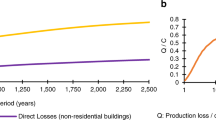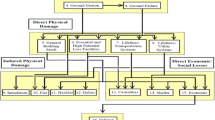Abstract
Modeling the economic consequences of disasters has reached a high level of maturity and accuracy in recent years. Methods for providing reasonably accurate rapid estimates of economic losses, however, are still limited. This article presents the case for “reduced-form” models for rapid economic consequence estimation for disasters, and specifies and statistically estimates a regression equation for property damage from significant U.S. earthquakes. Explanatory variables are of two categories: (1) hazard-related variables pertaining to earthquake characteristics; and (2) exposure-related variables pertaining to socioeconomic conditions. Comparisons to other available earthquake damage estimates indicate that our Reduced-Form Model yields reasonably good results, including several statistically significant variables that are consistent with a priori hypotheses. The article concludes with a discussion of how the research can be enhanced through the collection of data on additional variables, and of the potential for the extension of the reduced-form modeling approach to other hazard types.
Article PDF
Similar content being viewed by others
Avoid common mistakes on your manuscript.
References
BEA (U.S. Bureau of Economic Analysis). 2012. Regional Economic Accounts. http://www.bea.gov/regional/.
Chan, L. S., Y. Chen, Q. Chen, L. Chen, J. Liu, W. Dong, and H. Shah. 1998. Assessment of Global Seismic Loss Based on Macroeconomic Indicators. Natural Hazards 17(3): 269–283.
Dixon, P., B. Lee, T. Muehlenbeck, M. Rimmer, A. Rose, and G. Verikios. 2010. Effects on the U.S. of an H1N1 Epidemic: Analysis with a Quarterly CGE Model. Quarterly CGE Model. Journal of Homeland Security and Emergency Management 7(1): Article 7.
ECLAC (Economic Commission for Latin America and the Caribbean). 2003. Handbook for Estimating the Socio—Economic and Environmental Effects of Disasters. http://web.worldbank.org/WBSITE/EXTERNAL/TOPICS/EXTURBANDEVELOPMENT/EXTDISMGMT/0,,contentMDK:20196047~menuPK:1415429~pagePK:210058~piPK:210062~theSitePK:341015,00.html.
Erdik, M., K. Sesetyan, M. B. Demircioglu, U. Hancilar, and C. Zulfikar. 2011. Rapid Earthquake Loss Assessment after Damaging Earthquakes. Soil Dynamics and Earthquake Engineering 31(2): 247–266.
ESRI. 2010. ArcGIS Software Program. Version 10.0. Redlands, CA.
FEMA (U.S. Federal Emergency Management Agency). 2012. HAZUS Website. http://www.fema.gov/hazus.
GEM (GEM Foundation). 2011. OpenQuake Book. Version 0.1. Pavia, Italy. http://www.globalquakemodel.org/media/cms_page_media/79/OpenQuake-Book_Version0.1.pdf.
Giesecke, J., W. Burns, A. Barrett, E. Bayrak, A. Rose, P. Slovic, and M. Suher. 2012. Assessment of the Regional Economic Impacts of Catastrophic Events: A CGE Analysis of Resource Loss and Behavioral Effects of a Radiological Dispersion Device Attack Scenario. Risk Analysis 32(4): 583–600.
Huyck, C. K., H-C. Chung, S. Cho, M. Z. Mio, S. Ghosh, R. T. Eguchi, and S. Mehrotra. 2006. Centralized Web-Based Loss Estimation Tool: INLET for Disaster Response. INLET for Disaster Response. In Nonintrusive Inspection, Structures Monitoring, and Smart Systems for Homeland Security, edited by A. A. Diaz, H. F. Wu, S. R. Doctor, and Y. Bar-Cohen. Proceedings of SPIE, Vol. 6178: Paper 61780B.
Jaiswal, K. S., and D. J. Wald. 2011. Rapid Estimation of the Economic Consequences of Global Earthquakes. U.S. Geological Survey Open-File Report 2011-1116. http://pubs.usgs.gov/of/2011/1116/.
Knittle, A. 2011. Virginia Quake’s Aftermath Helps Officials in Oklahoma. The Oklahoman, November 17, 16A.
Loayza, N. V., E. Olaberria, J. Rigolini, and L. Christiaensen. 2012. Natural Disasters and Growth: Going Beyond the Averages. World Development 40(7): 1317–1336.
MathWorks, Inc. 2011. Matlab Software Program. Version R2011b. Natick, MA.
Morello, C., and O. Wiggins. 2011. Region Tallies Earthquake Damage, Mostly Uninsured. Washington Post, August 24. http://www.washingtonpost.com/local/region-tallies-earthquake-damage-mostlyuninsured/2011/08/24/gIQAFdxScJ_story.html.
NGDC (National Geophysical Data Center). 2011. Significant Earthquake Database. U.S. National Oceanic and Atmospheric Administration. http://www.ngdc.noaa.gov/nndc/struts/form?t=101650&s=%201&d=1.
NHC (U.S. National Hurricane Center). 2010. Latitude/Longitude Distance Calculator. http://www.nhc.noaa.gov/gccalc.shtml.
NRC (National Research Council). 2009. National Earthquake Resilience: Research, Implementation and Outreach. Washington, DC: National Academy Press.
Rose, A. 2004. Economic Principles, Issues, and Research Priorities in Natural Hazard Loss Estimation. Natural Hazard Loss Estimation. In Modeling the Spatial Economic Impacts of Natural Hazards, edited by Y. Okuyama and S. Chang, 13–36. Heidelberg: Springer.
Rose, A. 2009. A Framework for Analyzing and Estimating the Total Economic Impacts of a Terrorist Attack and Natural Disaster. Economic Impacts of a Terrorist Attack and Natural Disaster. Journal of Homeland Security and Emergency Management 6(1): Article 4.
Rose, A. 2013. Macroeconomic Consequences of Terrorist Attacks: Estimation for the Analysis of Policies and Rules. Estimation for the Analysis of Policies and Rules. In Benefit Transfer for the Analysis of DHS Policies and Rules, edited by V. K. Smith and C. Mansfield. Cheltenham, UK: Edward Elgar Publishing Company (forthcoming).
Rose, A., and S. B. Blomberg. 2010. Total Economic Impacts of a Terrorist Attack: Insights from 9/11. Terrorist Attack: Insights from 9/11. Peace Economics, Peace Science, and Public Policy 16(1): Article 2.
Rose, A., D. Wei, and A. Wein. 2011. Economic Impacts of the ShakeOut Scenario. Earthquake Spectra: Special Issue on the ShakeOut Earthquake Scenario 27(2): 539–557.
Schumacher, I., and E. Strobl. 2011. Economic Development and Losses Due to Natural Disasters: The Role of Hazard Exposure. Ecological Economics 72: 97–105.
SSHELDUS (Spatial Hazard Events and Losses Database for the United States, Version 9.0). 2011. Hazards and Vulnerability Research Institute, University of South Carolina. http://webra.cas.sc.edu/hvri/products/sheldus.aspx.
Stover, C. W., and J. L. Coffman. 1993. Seismicity of the United States, 1568–1989 (revised). U.S. Geological Survey Professional Paper No. 1527. Washington, DC: U.S. Government Printing Office. http://pubs.er.usgs.gov/publication/pp1527.
Stover, F. 2010. Governor Estimates Earthquake Damages May Exceed $43 Million. Humboldt Beacon (Fortuna, CA), January 21. http://www.humboldtbeacon.com/news/ci_14238890.
Sue Wing, I., A. Rose, and A. Wein. 2010. Economic Impacts of the ARkStorm Scenario. ARkStorm Scenario. In Overview of the ARkStorm Scenario, edited by K. Porter, A. Wein, C. Alpers, A. Baez, P. Barnard, J. Carter, A. Corsi, J. Costner, D. Cox, T. Das, M. Dettinger, J. Done, C. Eadie, M. Eymann, J. Ferris, P. Gunturi, M. Hughes, R. Jarrett, L. Johnson, H. Dam Le-Griffin, D. Mitchell, S. Morman, P. Neiman, A. Olsen, S. Perry, G. Plumlee, M. Ralph, D. Reynolds, A. Rose et al. USGS Open-File Report 2010-1312.
U.S. Census Bureau. 2010. American Community Survey. http://www.census.gov/acs/www/.
U.S. Census Bureau. 2012a. Centers of Population for the 2010 Census. http://www.census.gov/geo/www/2010census/centerpop2010/centerpop2010.html.
U.S. Census Bureau. 2012b. State and County QuickFacts. http://quickfacts.census.gov/qfd/states/.
USGS (U.S. Geological Survey). 2012a. PAGER — Prompt Assessment of Global Earthquakes for Response. http://earthquake.usgs.gov/earthquakes/pager/.
USGS (U.S. Geological Survey). 2012b. ShakeMaps. http://earthquake.usgs.gov/earthquakes/shakemap/.
Author information
Authors and Affiliations
Corresponding author
Additional information
This article is published with open access at Springerlink.com
Rights and permissions
Open Access This article is distributed under the terms of the Creative Commons Attribution 2.0 International License (https://creativecommons.org/licenses/by/2.0), which permits unrestricted use, distribution, and reproduction in any medium, provided the original work is properly cited.
About this article
Cite this article
Heatwole, N., Rose, A. A reduced-form rapid economic consequence estimating model: Application to property damage from U.S. earthquakes. Int J Disaster Risk Sci 4, 20–32 (2013). https://doi.org/10.1007/s13753-013-0004-z
Published:
Issue Date:
DOI: https://doi.org/10.1007/s13753-013-0004-z




